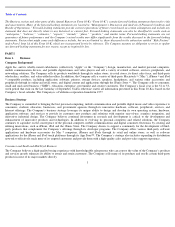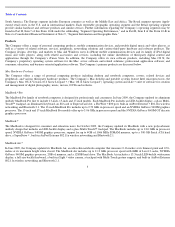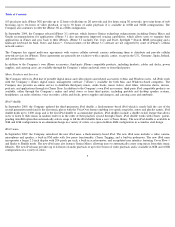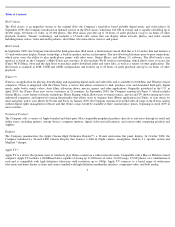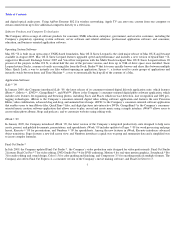Apple 2009 Annual Report Download - page 13
Download and view the complete annual report
Please find page 13 of the 2009 Apple annual report below. You can navigate through the pages in the report by either clicking on the pages listed below, or by using the keyword search tool below to find specific information within the annual report.
Table of Contents
The Company’s future financial condition and operating results are substantially dependent on the Company’
s ability to continue to develop and
offer new innovative products and services in each of the markets it competes in.
Raw Materials
Although most components essential to the Company’
s business are generally available from multiple sources, certain key components including
but not limited to microprocessors, enclosures, certain liquid crystal displays (“LCDs”), certain optical drives, and application-
specific integrated
circuits (“ASICs”)
are currently obtained by the Company from single or limited sources, which subjects the Company to significant supply and
pricing risks. Many of these and other key components available from multiple sources including but not limited to NAND flash memory,
dynamic random access memory (“DRAM”), and certain LCDs, are subject at times to industry-
wide shortages and significant commodity
pricing fluctuations. In addition, the Company has entered into certain agreements for the supply of key components including but not limited to
microprocessors, NAND flash memory, DRAM and LCDs at favorable pricing, but there is no guarantee the Company will be able to extend or
renew these agreements on similar favorable terms, or at all, upon expiration or otherwise obtain favorable pricing in the future. Therefore, the
Company remains subject to significant risks of supply shortages and price increases that can materially adversely affect its financial condition
and operating results.
The Company and other participants in the personal computer, mobile communication and consumer electronics industries also compete for
various components with other industries that have experienced increased demand for their products. In addition, the Company uses some
custom components that are not common to the rest of the personal computer, mobile communication and consumer electronics industries, and
new products introduced by the Company often utilize custom components available from only one source until the Company has evaluated
whether there is a need for, and subsequently qualifies, additional suppliers. When a component or product uses new technologies, initial
capacity constraints may exist until the suppliers’ yields have matured or manufacturing capacity has increased. If the Company’
s supply of a
key single-
sourced component for a new or existing product were delayed or constrained, if such components were available only at significantly
higher prices, or if a key manufacturing vendor delayed shipments of completed products to the Company, the Company’
s financial condition
and operating results could be materially adversely affected. The Company’
s business and financial performance could also be adversely
affected depending on the time required to obtain sufficient quantities from the original source, or to identify and obtain sufficient quantities
from an alternative source. Continued availability of these components at acceptable prices, or at all, may be affected if those suppliers decided
to concentrate on the production of common components instead of components customized to meet the Company’s requirements.
Significant portions of the Company’
s Mac computers, iPhones, iPods, logic boards and other assembled products are manufactured by
outsourcing partners, primarily in various parts of Asia. A significant concentration of this outsourced manufacturing is currently performed by
only a few of the Company’s outsourcing partners, often in single locations. Certain of these outsourcing partners are the sole-
sourced suppliers
of components and manufacturing outsourcing for many of the Company’
s key products, including but not limited to final assembly of
substantially all of the Company’s portable Mac computers, iPhones, iPods and most of the Company’
s desktop products. Although the
Company works closely with its outsourcing partners on manufacturing schedules, the Company’
s operating results could be adversely affected
if its outsourcing partners were unable to meet their production commitments. The Company’
s purchase commitments typically cover the
Company’s requirements for periods ranging from 30 to 150 days.
The Company believes there are several component suppliers and manufacturing vendors whose loss to the Company if they were to encounter
financial distress or become insolvent, incur capacity or supply constraints, become unable to obtain credit, or for any other reason could
materially adversely affect the Company’
s business and financial condition. At this time, such vendors include, without limitation, 3M Co.,
Advanced Micro Devices Inc., AKM Semiconductor Inc., Amkor Technology Inc., Analog Devices Inc., Aptina Imaging Corp., ARM Holdings
PLC., Atheros Communications Inc., Atmel Corp., AU Optronics Corp., Avago Technologies Ltd.,
10



